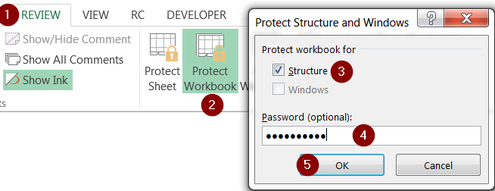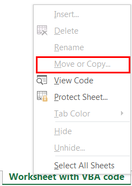Security Tip: Learn How To Protect Your Code
VBA code stored in worksheets (document modules) can be read from workbooks with unprotected structure (Review > Protect Workbook), even if the VBA project is password locked or unviewable. This hack can be demonstrated with the following simple steps:
The workaround for this problem involves 2 steps:
- Store event code in a worksheet
- Lock the VBA project with a password (VBE > Tools > VBAProject Properties > Protection)
- Copy the worksheet with the event code to a new workbook
The workaround for this problem involves 2 steps:
- Protect the workbook's structure:
File > Info > Protect Workbook > Protect Workbook Structure or
Review > Protect Workbook > [Protect workbook for structure] to prevent worksheet copying. - Include only minimal code in the worksheets. Place the bulk of any such code in a standard module and call on it from the worksheet.
'USE: Private Sub Worksheet_SelectionChange(ByVal Target As Range) Call UserKeyPress(Target) 'procedure stored in a standard module End Sub 'INSTEAD OF... Private Sub Worksheet_SelectionChange(ByVal Target As Range) On Error Resume Next Application.EnableEvents = False 'Condition added to prevent further moves after game is won - PB If Not ThisWorkbook.Sheets("Game").Shapes("YouWin").Visible Then If Not Intersect(Target, [key.left]) Is Nothing Then LeftArrowPressed If Not Intersect(Target, [key.right]) Is Nothing Then RightArrowPressed If Not Intersect(Target, [key.up]) Is Nothing Then UpArrowPressed If Not Intersect(Target, [key.down]) Is Nothing Then DownArrowPressed End If ThisWorkbook.Sheets("Game").Range("Active").Select Application.EnableEvents = True End Sub
Protect VBA Code With Unviewable+
What if you didn’t need to worry about others modifying or even stealing your code? With the Unviewable+ VBA project, this thought is now a reality!
How To Copy Worksheets Without Embedded Code
There are times when worksheets with VBA code may have to be copied (manually or by VBA) and saved to a new workbook:
Sheets("Sheet1").Copy
ActiveWorkbook.SaveAs ...
An error or unexpected results could occur, if the event code is triggered in the new workbook, besides the fact that the code would be readable without a VBE password, as discussed earlier.
Here are several options, which could be used to exclude the VBA event code from being included in the new workbook:
Sheets("Sheet1").Copy
ActiveWorkbook.SaveAs ...
An error or unexpected results could occur, if the event code is triggered in the new workbook, besides the fact that the code would be readable without a VBE password, as discussed earlier.
Here are several options, which could be used to exclude the VBA event code from being included in the new workbook:
- Save new workbook in a macro-free format, when using Excel 2007 or later version (xlOpenXMLWorkbook, see XlFileFormat Enumeration)
- Copy the data range (not the source sheet) to a new macro-free (document module) worksheet
- Delete all worksheet event code in the destination worksheet using the VBA extensibility library.
The function shown below deletes code inside Excel document modules:
Option Explicit Function DeleteEventVBACode(sDocument As String) As Long ' Add reference to VBA Extensibility library, if early binding is used ' ThisWorkbook.oVBProjectect.References.AddFromGuid _ ' GUID:="{0002E157-0000-0000-C000-000000000046}", _ ' Major:=5,Minor:=3 Const vbext_pp_none = 0 Const vbext_ct_Document = 100 Dim oVBProject As Object Dim oVBComponent As Object Dim oCodeModule As Object Dim lLineCount As Long On Error GoTo ERR_HANDLER Set oVBProject = ActiveWorkbook.oVBProjectect If oVBProject.Protection = vbext_pp_none Then For Each oVBComponent In oVBProject.oVBComponentonents If oVBComponent.Type = vbext_ct_Document And _ oVBComponent.Name = sDocument Then Set oCodeModule = oVBComponent.oCodeModuleule With oCodeModule lLineCount = .CountOfLines .DeleteLines 1, lLineCount End With End If Next oVBComponent DeleteEventVBACode = lLineCount Else DeleteEventVBACode = 0 End If Exit Function ERR_HANDLER: DeleteEventVBACode = -1 End Function









